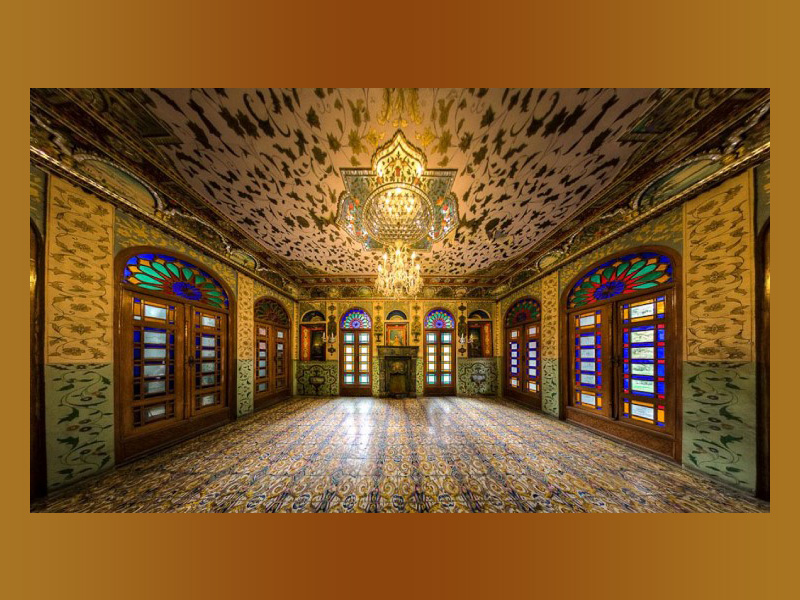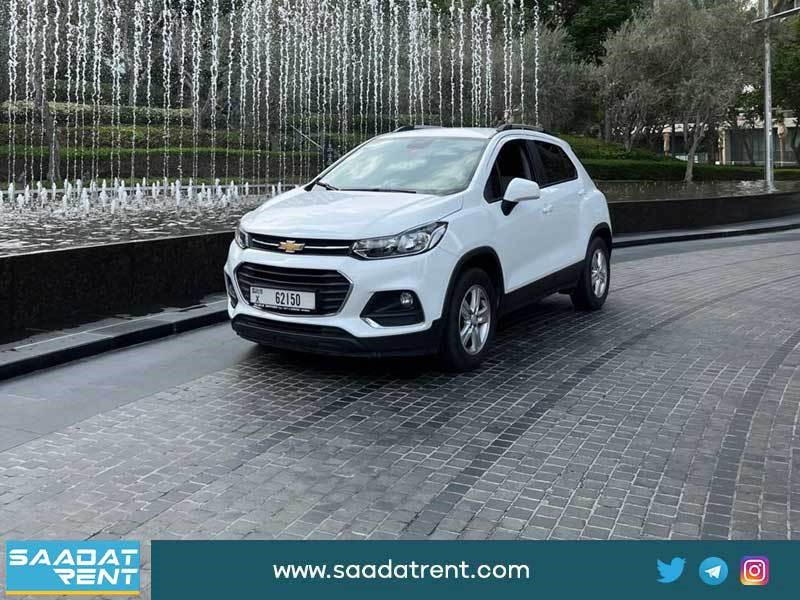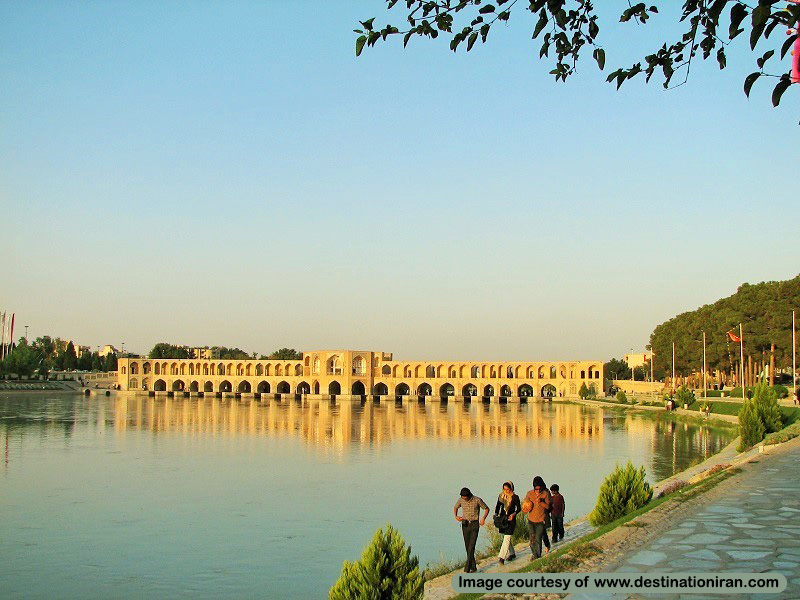
The city of Isfahan is famous for its valuable monuments built during different historical periods. Some of the most exciting tourist attractions in Isfahan are historical bridges. In addition to their primary function, the bridges of Isfahan are breathtakingly beautiful. One of these beautiful bridges is the Khaju Bridge of Isfahan.
Khaju Bridge is located east of the Si O Se Pol (bridge). This bridge showcases stability, symmetry, and a unique architectural style. Khaju bridge of Isfahan was known as the most beautiful bridge during the Safavid period.
History, Function, and Other Names Khaju Bridge of Isfahan
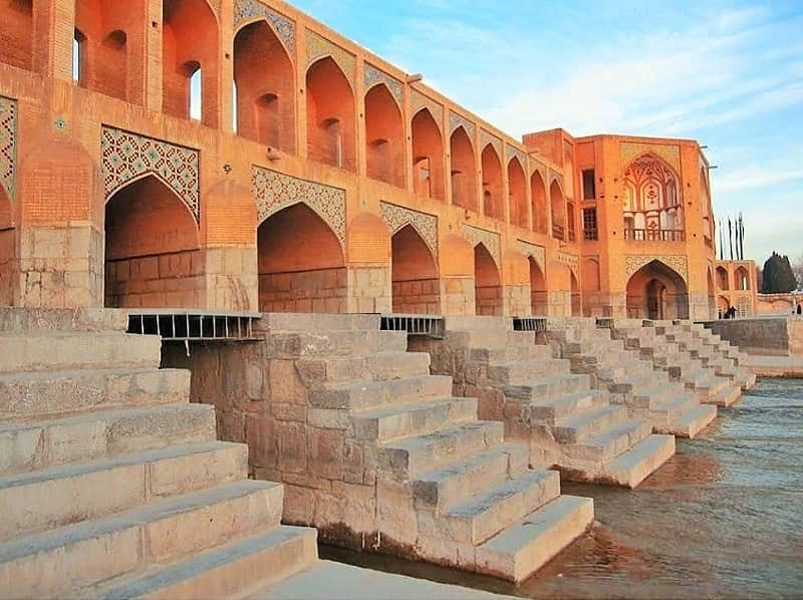
Out of all the bridges built over the rivers of Isfahan city, Khaju Bridge is among the most famous. This bridge is built on Zayandeh Rud (river), 1800 meters away from Si O Se Pol. Khaju Bridge was built over the remains of a bridge known as Hasan Beyg Bridge, a lost monument from the Timurid period.
The bridge dates back to the Safavid period and Shah Abbas II. He ordered the construction of the bridge over Zayandeh Rud in 1650 AD. This bridge connected the Khajoo district of Isfahan and Hasan Abad gate with Takht-e Foulad and Isfahan-Shiraz road.
In addition to connecting the neighborhoods we mentioned, the Khaju bridge also served as a dam. Although the function of the bridge is different from conventional dams. As a dam, it was designed to create a small lake for recreational use, such as boat riding.
There is a parlor called Shahneshin (the king’s residence) in the middle of the bridge. This building was a recreational area designed for Shah Abbas and his family. Shahneshin is known as Bigler Beigi parlor and is decorated with beautiful paintings on its arches.
There is an inscription on the southern part of the bridge. This inscription shows that Khaju Bridge was restored in 1873 AD, during the reign of Naser al-Din Shah, the king of the Qajar era.
Isfahan’s Khaju Bridge is also known as Baba Rokneddin, Gabrha Bridge, Hassan Abad, and Shahi Bridge. Here are some of the reasons for the different names of the bridge.
- Baba Rokneddin: Khaju Bridge of Isfahan is known by this name because of its proximity to the tomb of Baba Rokneddin in Takht-e Foulad.
- Gabrha Bridge: It was called by this name because of the Gabrs (Zoroastrians) commuting on the bridge. The word Gabr used to refer to all non-Muslims, but today it means “large”.
- Hassan Abad Bridge: Since the old name of the Khaju neighborhood was Hassan Abad, this bridge is also known as Hassan Abad Bridge.
- Shahi Bridge: Since Shah (king) Abbas II ordered the construction of the bridge, it is also known as Shahi bridge.
Features of Khaju Bridge in Isfahan
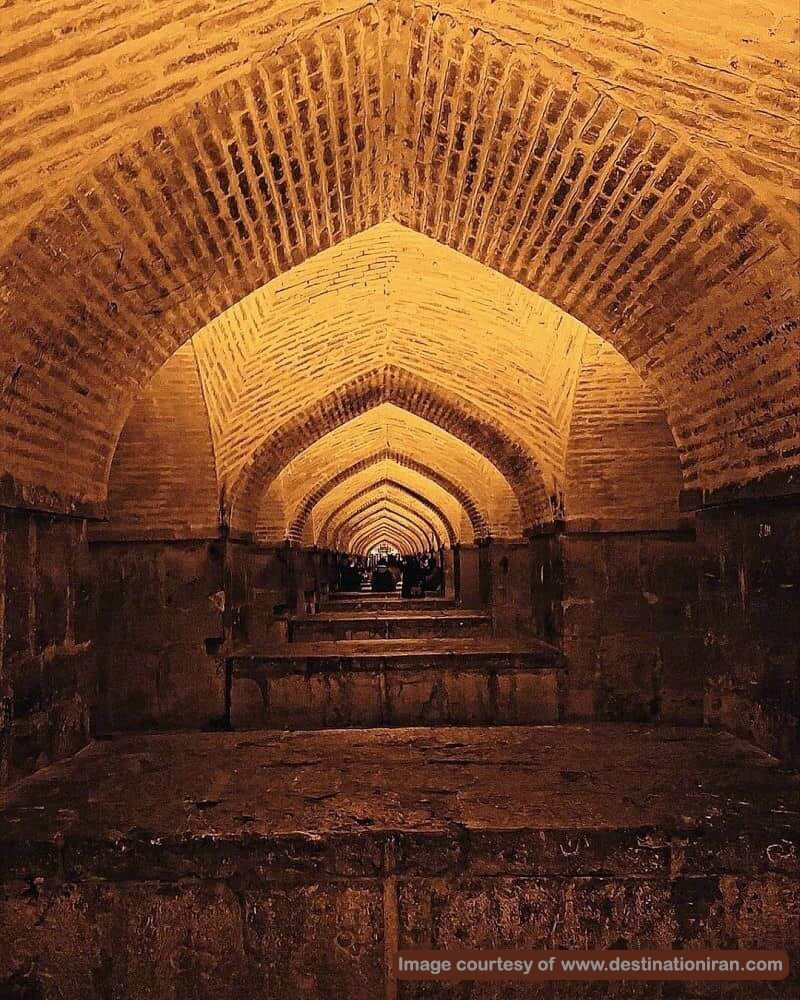
Khajoo Bridge is about 133 meters long and 12 meters wide. Also, this bridge has a 7 meters wide passage for pedestrians.
The piers on top of the bridge are pointed upward and act as a water-cutting element. The piers’ pointed shape minimizes the river’s water pressure on the bridge. Also, the lower part of the bridge piers acts as a barrier to reduce water flow during floods. These piers lead the water to the canals. With this measure, the underground water reserves are replenished.
The crossing of Khaju Bridge features barrel vaults and Araghchin domes. The vaults in old Iranian were usually added to improve the bridge’s stability and increase its load-bearing properties.
Two stone lions are on both sides of the Khaju Bridge of Isfahan. These lions are a symbol of the Bakhtiari warriors, who were the city’s protectors during the Safavid era. The stone lions are decorated with symbols of Pahlevani and Zoorkhaneh rituals (traditional Persian sports). At sunset, the eyes of the stone lions shine so brightly, resembling artificial lights. A Qiblah marker is carved on a stone slab (direction of Ka’aba) near one of the stone lions.
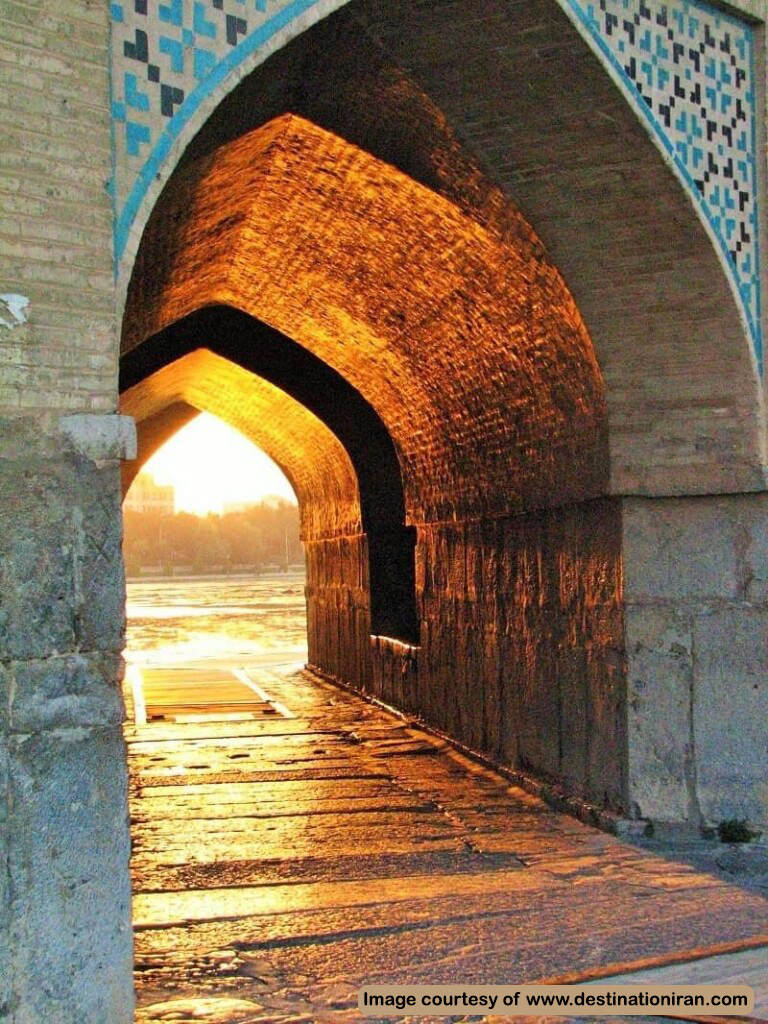
This bridge has 24 spans in the form of cubes. These cubic spans are delicately constructed. Wooden dams are utilized to barricade the middle segment of the bridge.
Due to the arrangement of the bridge spans, you can see an opening in the shape of a candle. This candle shape is leaning toward the lower spans and is located at a 30 degrees angle from the exterior eastern spans of the bridge.
The ceiling of the Khaju Bridge of Isfahan is shaped like an arc or an eye. This eye-shaped ceiling has a protruding edge. The walls of Khaju Bridge are also built with stone. There are markings on the stone slabs. These marks appear to be the signatures of the bridge builders.
The exterior of the walls of Khaju Bridge is decorated with seven-color tiles and gilding. The pavilions on the side and top of the bridge are covered with Alvan (polychrome) tiles.
Do Not Miss Visiting This Attraction
Traveling to the city of Isfahan and walking on the beautiful bridges of this city feels like a dream. If you travel to this city as part of an Iran tour package or by yourself, make sure to visit the Khaju Bridge of Isfahan. Seeing this bridge will take you back to the Safavid period and demonstrate the craft of the architects from that period.
Destination Iran recommends browsing Isfahan tourist attractions post before traveling to the city. This beautiful city has many historical monuments that can mesmerize you for many days.
Where is The Khaju Bridge?
Khaju Bridge is located in Isfahan on the Zaindeh Rud (river) and connects Khaju Square in the north of the river to Feyz Boulevard in the south. You can see the exact location of this bridge below:
Frequently Asked Questions About Khaju Bridge of Isfahan
If you cannot find the answer to your question here, leave us a comment in the comment section below this post and ask your question. We will answer it as soon as possible.
In what period was the Khaju bridge built, and who ordered it?
Khaju Bridge dates back to the Safavid period and the reign of Shah Abbas II. He ordered the construction of this bridge in 1650 AD.
What are the other names of the Khaju Bridge in Isfahan?
Khajoo Bridge of Isfahan is also known as “Baba Rokneddin”, “Gabrha Bridge”, “Hassan Abad Bridge”, and “Shahi Bridge”.
What are the prominent architectural features of Isfahan’s Khaju bridge?
Khajoo Bridge of Isfahan is 133 meters long and 12 meters wide, with 23 barrel vaults. This arc-shaped design transfers the bridge’s load to the support structures on both sides, preventing horizontal drift and collapse. The tiling decorations and octagonal pavilions of the Khaju bridge have distinguished it from other bridges in Isfahan. With its unique architecture, the Khaju Bridge functions as a dam and a weir, controlling the river’s water flow.
What are the differences between the Khajoo bridge and Si-o-Se-Pol?
Si-o-Se-Pol has 33 barrel vaults, while Khaju Bridge has 23. The main difference between Isfahan’s Khaju Bridge and Si-o-sS-Pol is the presence of the “Biglar Beigi” parlor in the middle of the Khaju Bridge. This building was the recreational palace for Shah Abbas II and his family.
What are the wonders of Khaju Bridge?
From above, the water passing through the Khajoo bridge forms a stunning pattern similar to an eagle’s talon. In addition, if we look at the piers from the east at a right at sunset, we can see the space between the arches in the shape of a candle, which is the result of the arrangement of the stones and the protrusions and indentations of the piers of the Khaju bridge of Isfahan.






